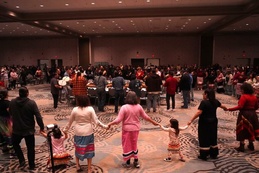Mariah fights winds of controversy
July 12, 2009
Mariah Fights Winds of ControversyBy Anne Stanton 7/13/09
Governor Jennifer Granholm is relying on the “green” industry to pull
Michigan out of its economic mire, but environmentalists say that careful
research is needed to get the most out of your money.
At issue is the Mariah Windspire, a graceful looking and quiet
vertical-axis wind turbine.
In April, Gov. Granholm applauded the $5 million MasTech factory as a
model of the green direction Michigan wants to go.
With a promise of 140 jobs in three years at the Manistee plant, the
project was supported with a $400,000 grant from the Michigan Economic
Development Corporation.
In May, the Windspire was given away on ABC’s Extreme Makeover television
show, becoming the “star of the job site, garnering much attention from
the crew and surrounding community,” according to the company’s press
release.
“Windspire’s plug ’n’ produce design connects directly to the household
power supply, offsetting electricity use and reducing energy costs.”
EARLY PROBLEMS
That’s all true, but a test on an early unit was abruptly terminated in
January after multiple mechanical problems over an eight-month period. The
test was conducted by the National Renewable Energy Laboratory and the
Department of Energy.
In a phone interview, Mariah President Mike Hess said the mechanical
problems that were flagged in the NREL test have been fixed. Part of the
problem: the company wasn’t allowed to replace the initial turbine, which
had a bad inverter.
“We’ve fixed all that. That was part of the 18 design changes we made
before the turbine went into production. We have a test unit in the
backroom—we ran it for 10 million cycles to prove we don’t have a problem.
Those are tests that we do, which is part of the development. It isn’t
something we made in our garage.”
Hess added that the Windspire has a streamlined, integrated design that
ensures long-term durability. The Windspire also carries a five-year
warranty.
A tour of the Mastech plant, which now employs about 40 people, was led by
John Holcomb, the general manager, who was visibly proud of his 40
employees. He showed off the super-strong magnets inside the column, which
allows the spire to “float” in its operation and eliminates the need for a
gear box.
In its former life—before the auto industry self destructed—Mastech
designed robotic machinery for auto plants. Now it has applied precision
robotics to building the Windspire.
Several turbines have been returned as defective, but those were produced
in Reno, not Manistee, which began commercial production in May. The
company is doing the right thing by fixing the turbines free of charge or
replacing the turbines entirely, said Holcomb who replaced a Windspire in
Fremont last week.
“I’ve been building machinery for 30 years, and there’s always the
possibility of a mistake. How you react to it and how
you take care of it sets you apart from everyone else. And they are taking
care of it,” he said.
TRULY URBAN?
Start-up problems aside, environ-mentalists on the Internet are
challenging the claims for the Windspire. Unlike horizontal wind turbines
that capture the highest winds at 100-plus feet in the air, the Windspire
reaches only 30 feet, where wind speeds are slower.
“On Mariah’s website, they’re showing a wind turbine next to all kinds of
obstructions — buildings and trees — and claiming they’re getting an
average of 12 mph wind. It’s very misleading, and I’m worried people are
getting victimized,” said Ian Woofenden, who has used wind energy since
the early 1980s, has taught wind energy workshops for 14 years, and is
senior editor of Home Power Magazine, which takes a practical approach
toward renewable energy.
Woofenden said wind speeds of 12 mph are rarely attained in urban areas
and are usually much less. For confirmation, he advised consulting the
Warwick Wind Trials report, which independently tested rooftop turbines
(Mariah’s wind turbine stands 30 feet high).
Woofenden, who describes himself more of a “pie on the plate” rather than
“pie in the sky” kind of thinker, believes that Windspire let its
marketing get ahead of its engineering. He is impatient with the whole
debate, having seen a series of vertical wind turbine companies come and
go over the years.
RIGHT FOR SOME
In a phone conversation from his office in Las Vegas, Hess bristled at
his critics, saying they are resistant to anything new.
“You do get better winds with a 100-foot tower. That’s a scientific fact,
but you can’t do that in an urban environment. Your neighbor won’t let you
do that. The application of what we’re trying to do is significantly
different because you don’t have the height allowance in urban areas.”
Hess agrees that a potential buyer should ensure their site has an average
wind speed of 12 mph to achieve the desired 2,000 kilowatt hours per year.
The company is offering a performance guarantee and will compensate any
purchaser that doesn’t get the performance shown on the company’s wind and
power curve.
“They really put their neck out on the line with the power production
guarantee. No one has ever done that before. There is none for small wind
except for Mariah,” said Allan O’Shea of Contractors Building Supply in
Copemish, which sells the Windspire along with other energy-saving
products.
According to the curve, the estimated savings for an average electrical
bill would knock off $220 from the average $1,235 annual electric bill.
That’s based on a 12 mph wind site and utility costs of 11 cents per
kilowatt hour. Those savings would be recouped over 29 years, assuming
that utility costs remain the same and no maintenance or repairs are
required.
O’Shea said most of the units he sells have a pay-off of between 15 to 18
years. That pay off assumes electrical rates will increase 10 percent per
year.
BUILDING FENCES?
But Woofenden says the assumption of paying nothing for repairs or
maintenance is highly unlikely and nearly impossible.
“When I’ve asked owners of vertical wind turbines, how many kilowatt
hours do you get and crunch the numbers, I tell them, ‘I’m the bearer of
bad news. You are paying far more than you would have paid if you bought
the electricity from your utility.’ I have seen installations where the
wind electric is costing $4 a kilowatt hour and the local utility is 10
cents a kilowatt hour. Those are the results you get with short towers
next to houses and trees.”
O’Shea believes too many “pundits” like Woofenden are building fences
around the industry, stifling innovation and growth.
O’Shea said he takes an honest approach with customers, conducting an
energy audit and advising how to best save energy and money. It might be
insulation. Might be better windows. The most committed people will begin
with the cheapest fixes and progress toward a wind turbine and solar
panels.
O’Shea agrees that the advertising of Mariah’s literature is misleading
when it shows a wind turbine operating in a wooded subdivision, but he
would never sell a turbine in that setting. He turned down three
interested customers last week, but installed a Windspire at a windy site
off I-75 near the Mackinac Bridge.
“We’ll probably sell 60 turbines in Michigan this year, but 25 percent of
the world doesn’t have electricity, so there’s a huge market out there,”
he said.
PHENOMENAL WIND
Hess said there’s a place for a vertical wind turbine—very high wind
areas, especially in townships and cities that ban high, horizontal
towers.
“Along the coastline, we are in a phenomenal wind area. It’s a great way
to make renewable energy and you’ve gotta take advantage of it,” said Jim
Barnes of Eco-Building Products in Traverse City.
“There are places where it will work—a coastal area, a place with no
trees, the wind is close to the ground, and that’s okay. But that’s not
most places,” said Mike Bergey, president of Bergey Windpower. “I
actually don’t have a problem with Mariah selling what they have. As far
as I’ve ever seen, they’ve been honest about their performance and what to
expect, and if people want to buy that, it’s well engineered.”
The company plans to make a low-wind model that will capture wind at
speeds as low as five to six mph, as well as a
high-wind model that will survive 160 mph winds. Those are needed for
communica-tion towers located in remote mountain-
ous areas.
Woofenden contends that even if the wind is strong near the ground along
the coastline, it’s stronger up high where
there is also less turbulence. The latter factor is important because wind
turbulence causes mechanical fatigue. He argues that
if zoning doesn’t permit a 100-foot tower, then residents should fight to
change it.
OFF THE GRID
Duncan and Maggie Sprattmoran live in a hybrid type of house, powered by
solar in the sunny months, wind in the darker months, and propane to run
the refrigerator. They also heat their home with wood. Their decision to
operate their Leelanau County home off the grid 20 years ago was somewhat
prompted by the $13,000 price tag from Consumer’s Power to hook up.
But Maggie, who previously sold renewable energy products, said that it
was more about protecting the earth’s environment from pollution and
global warming than money.
“If we paid the real cost of coal-fired power plants, as we do with solar
and wind, the numbers would be huge. When we compare wind to coal, are we
really comparing apples to apples? So for me, when we raised our kids, I
thought a lot about the story I was going to tell them. What am I willing
to pay with income to say there’s an opportunity to do it a different way?
I’m sorry we live in a world that doesn’t ask us to be honest about that.
What come out of my checkbook is one piece of the conversation, but I wish
we talked about the real issues,” Maggie said.
WHAT TO DO?
At the end of the Mastech tour, Holcomb sheepishly admitted that his
electric bill for his old farm house was around $350 a month. O’Shea said
he has pared his energy bill to $60. The two men reflect the wide spectrum
of concern and action.
(Next week: ‘Is Wind Right for You?’)
ENERGY SAVERS
If you’re looking to save on energy—whether motivated by money or
ideals—here’s a list of where to start. These suggestions were provided by
O’Shea, Barnes, Woofenden and Gary Woodcock, owner of Healthy Green Homes.
• Number one, look for leaks of cold (or hot) air. The cheapest way to
bring down your energy bill is to seal those leaks, which may involve
replacing old windows.
• After tightening your home, improve your insulation. Heat travels
vertically and radiates through the roof. Blow in 15 inches of
cellulose insulation.
• Get rid of your old refrigerator if it’s not energy efficient.
• Solar hot water collectors are wise investments, but don’t invest in
solar if your water tank and piping aren’t insulated, which wastes
energy. Here’s a really cheap idea: put an extra blanket around the
water tank to keep the heat in.
• Replace standard light bulbs with long-lasting LED light bulbs.
• Lower the temperature of your hot water heater.
• Turn off your lights and computer when you’re not using them.
• Watch a smaller TV. The bigger the TV, the more energy it eats.
• Deal with phantom loads (electricity that is used when an appliance is
turned off) by using plug strips and turning them off. When you buy
a new appliance, ask about phantom loads.
• Solar technology is expensive, but panels come with a 25-year
warranty and are extremely reliable without the maintenance issues
of wind turbines. “They’re pricey up front, but you’re buying 50
years,”
Woofenden said.
Bottom line, do your research, crunch the numbers, and don’t trust the
media, said Woofenden.
Trending

Our Top Stories of 2025
Each year, we look back at the stories we’ve shared over the last 12 months and pull together the ones that got the mo… Read More >>
A Solo Rattler
Frontman of folk-rock band Michigan Rattlers Graham Young brings his solo performance to Great Lakes Center for the Arts in … Read More >>
GTB Starting the Year with Tradition
The Grand Traverse Band of Ottawa and Chippewa Indians hosts the Kchi Wiikwedong Anishinaabek Maawnjidowin Round Dance on Ja… Read More >>


